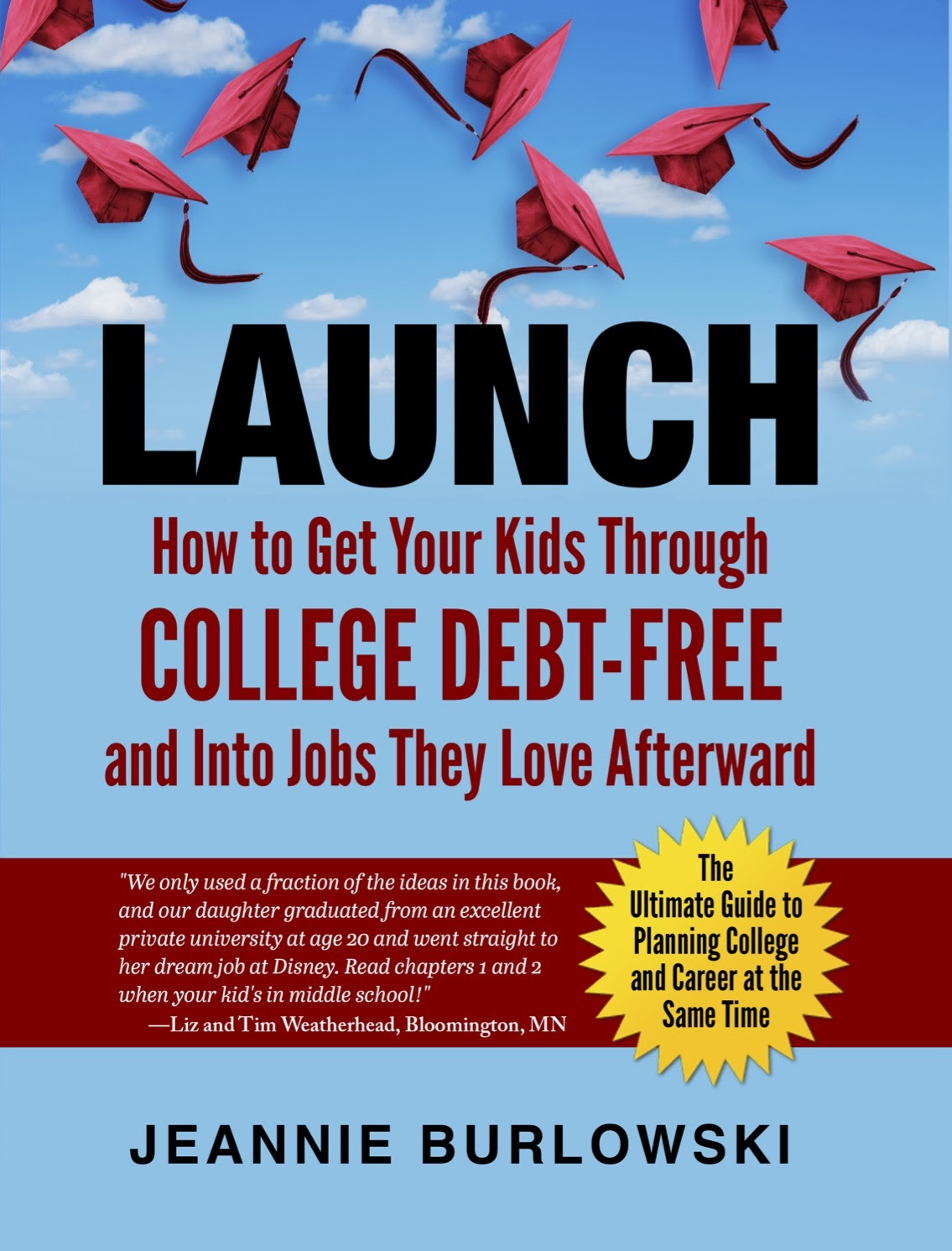What are the chances that you could get your high schooler excited about saving in a Roth IRA?
Better than you think—if you refuse to do it the old-fashioned way, using lectures and deprivation and drudgery.
This post is designed to help you inspire your child to want to save and invest, by introducing the topics in a creative and exciting way, with opportunity and immediate reinforcement.
How to get your kid excited about the Roth IRA
“Really, Jeannie Burlowski? The ROTH IRA? Shouldn’t we start by lecturing our son about his responsibility in paying for college, and push him to mow lawns to fatten up his college fund?”
My answer to this is, ah, “no.”
Let’s just look for a moment at how effective that would be.
It’s utterly discouraging to a teenager to spend a hot, sweaty afternoon mowing and trimming lawns, only to realize that he’d have to spend 3,600 afternoons just like that to pay for just one year of college tuition and living expenses at NYU. (He’s had his middle school math classes; he’s got the quantitative ability to figure this out.) If afternoon lawn mowing were going to get a kid through four years of a college like NYU, he’d need over 14,400 afternoons of it, which would take him about 39 years.
This is demoralizing, it’s paralyzing, and it makes a kid just not want to work at all.
Let’s not start there.
Instead, I suggest you start by telling your son that you have an ingenious idea for how he can make over $100,000 — and get to spend it on himself rather than on taxes or college bills.
That should get his attention.
Start out by explaining to your son just a thumbnail sketch of how paying for college actually works.
That starting in January of his sophomore year of high school, colleges are going to take a one-year snapshot of how much money your family has. They’re going to look only at the year stretching from January 1 of his sophomore year of high school to December 31 of his junior year of high school, and from that information they’re going to make a judgment about how much your family can probably afford to pay for college. Whatever your family can’t pay, colleges will try to come up with a plan for covering — but their plan will most likely include a lot of student loan debt that he absolutely doesn’t want.
Then lean in, look your son in the eye, and tell him: “Son, they’re going to be looking at all Mom and Dad’s money, and they’re going to figure that we can fork out about 5.6% of almost everything we have to pay for your college.” Then lean in even closer and drop the bomb. “But the schools are going to figure that you can fork over 20% of all the money that you’ve earned and saved, and they’ll require you to use that to pay your college bills. Are you excited about that?”
(He obviously will not be.)
Then continue.
Tell him that there is a safe, legal, and ethical place for him to hide his money, so that no one will come after it and try to get him to use it to pay college bills.
It’s called a Roth IRA.
Explain that starting the summer after 8th grade and stretching on for about 42 months, until December 31 of his junior year of high school, your son has a golden opportunity to make himself a tremendous boatload of money. If he will work hard and earn as much money as he can (up to a maximum of $5500 per year) during those 42 months, and put as much of that money as he can into a Roth IRA account, well, let’s just take a look at what could happen.
Explain to him that the money in his Roth IRA account will be invested, will enjoy the happy miracle of compound interest, and will grow and grow, until finally when he is 59 and 1/2 years old, he’ll have an astounding chunk of money to pull out tax free and spend in any way he wants to.
To illustrate this and make it real, pull out your smartphone if you have it handy, and take your son to the following website which contains a ROTH IRA earnings calculator: https://www.bankrate.com/calculators/retirement/roth-ira-plan-calculator.aspx.
Tell him that you believe that if he puts his mind to it, your son could easily find ways to earn $1000 each summer from now until he starts 11th grade, and $100 per month during each month he’s in school. If he does that, he’ll have $5200.00 saved up by December 1 of his junior year in high school. If, that week, he invests the whole thing in a Roth IRA, look at how much money he’ll have at age 59 and 1/2.
Run the figures in the little form on the Bankrate IRA calculator and let him see it on the phone with his own eyes: If his account earns 7% interest, he’ll have over $100,000, tax free, before age 60.
Then hand him the smart phone and let him play with the numbers. What happens if he works just a little harder and invests $6,200 when he’s 16 years old? Even if he never puts in another penny in his life, which is unlikely, he’ll have over $120,000, tax free, at age 60.
Sit there for just a moment and let that sink in.
Then make your proposal.
“Son, we know that there are a lot of things you want this summer. We know you’ve been talking to your friends about the water park and the movies and the state fair, and we know you’re hoping we’ll buy you a different bike and a new gaming console. You’re even hoping to get a car when you’re older, right?
He’ll nod his head, bracing himself.
“Well, son, we want you to have those things too. We honestly want you to have fantastic amounts of fun this summer. So we’ve set up a “fun fund” for you. We’ve put a clean, empty peanut butter jar up on the left side of that high shelf in the broom closet, and we’ve written FUN FUND on the side of it with a black Sharpie® marker. We put $20 in there for you to spend any way you want to. That’s your budget for fun for this summer.”
At this, your son will look stricken.
“But tell you what, son; we feel incredibly inspired to help kids who are focused on working hard and investing and saving for the future. So if you will work hard earning money this summer, for every dollar you earn and set aside for your Roth IRA investment, we’ll put $____ in your ‘fun fund.’ Count on us for up to $_____ per week, though; we’re not putting $50,000 in your ‘fun fund’ if you make that much money. Ha ha.”
Let all this sink in, and if objections or whining or tears result – sit quietly and patiently and kindly until the storm passes. When he’s ready to hear you talk again, tell him this:
“Son, we are so proud of you – you’re going to be taking a huge step toward adulthood this summer. Thinking about finding work, working hard, saving for the future! This is one of the most grown-up things you can possibly do.
We want to help you as much as possible with this. So we’re going to do two things for you.
First, we’re going to limit your TV and video game time to seven hours a week so you’ll have plenty of time to do the things we’ve been talking about in this meeting.
Second, I’ll tell you what. When you’re ready, we’ll help you to research and come up with some incredibly clever, super fun ways that you can earn money this summer. It doesn’t have to be lawn mowing. The internet has thousands of cool ideas that teens can use to earn money. Sometimes a TON of money. Did you hear about the 14-year-old kid who started up bizchair.com, the furniture site? He made $58 million. Or the kid who took his grandma’s strawberry jam recipe, started making it and selling it around his neighborhood, and now he’s the CEO of Super Jam, a company with $1 million a year in sales?
If you ask us, we’ll gladly help you to figure out some interesting ways for you to make money. And we’ll also get you started keeping careful records in Evernote® of exactly what you earned and how you earned it, because you can only put money into a Roth IRA if you earned it yourself. And you know what’s super cool about this whole concept? Some day you’ll be able to write essays that tell colleges all about the clever ways you earned this money, and they’ll say: ‘Wow; this kid’s amazing! We’ve got to have him here. Let’s give him an extra $10,000 to pay his college bills if he’ll agree to come to our school!’”
Let him take this all in, and when your son is ready to hear a little more, continue.
Pull out your smart phone again. “Now, son, you don’t have to make your money on the internet of course. You know that. But just for a little inspiration, let’s just take a look at the infographic on this website. Here’s one short page that tells us 200 different ways that people make money online:
https://www.bitrebels.com/business/ways-to-make-money-online/
Do you think there might be some ideas in there that could help you out?”
For clear, step-by-step help getting your kids through college debt-free, get your copy of my book:
Important—> It’s a reference book, so nobody reads the whole thing cover to cover. Pick out what you need to read in it using the fast-paced, 10-minute video instructions here.
You can see hundreds of reviews of this book on Amazon by going to:
Read just one chapter of LAUNCH every 1–3 months while your child’s in middle school and high school, and you’ll know every viable strategy for debt-free college at exactly the right time to implement it.
And if your child’s already well past middle school? That’s OK; you can run to catch up. But the process of getting your kids through college debt-free goes more smoothly the earlier you start—especially if you’re not planning to save up any money to pay for college.
Let's you and I walk together toward the goal of debt-free college for your kids.
We can accomplish this no matter your current income level—even if your kids never get a single scholarship.
Your first step is getting regularly scheduled, free helpful articles from me—right in your email inbox. Quick, sign up here.
Do you have very specific questions for me about debt-free college and career for your kids?
My TRIBE Members get the most direct access to me—while feeling good that the pennies per day they spend on the TRIBE help me bring debt-free college strategy to families who could never afford to pay for it. Join my TRIBE Membership waiting list here.
Who is Jeannie Burlowski?
Jeannie is a full-time academic strategist, podcast host, and sought-after speaker for students ages 12–26, their parents, and the professionals who serve them. Her writing, speaking, and podcasting help parents set their kids up to graduate college debt-free, ready to jump directly into careers they excel at and love. Her work has been featured in publications such as The Huffington Post, USA Today, Parents Magazine, and US News & World Report, as well as on CBS News.
Jeannie also helps students apply to law, medical, business, and grad school at her website GetIntoMedSchool.com. You can follow her on Bluesky @jburlowski.bsky.social.
No part of this article was written using AI.



